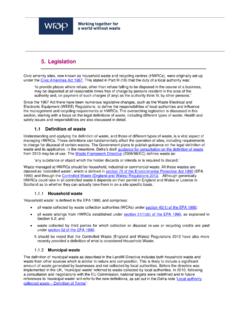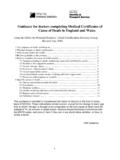Transcription of Memorandum of Understanding (MoU) between …
1 1 Memorandum of Understanding (MoU) between the Care Quality Commission (CQC) and the health and Safety Executive (HSE) December 2017 Introduction 1. This MoU has been agreed between the Care Quality Commission (CQC) and the health and Safety Executive (HSE) with the support of the Local Government Association (LGA). It applies to both health and adult social care in England. The purpose of this MoU is to help ensure that there is effective, co-ordinated and comprehensive regulation of health and safety for patients, service users, workers and members of the public. 2. It outlines the respective responsibilities of CQC, HSE and local authorities (LAs) in England when dealing with health and safety incidents in the health and adult social care sectors, and the principles that will be applied where specific exceptions to these general arrangements may be justified. The MoU applies to all activities; therefore it describes the principles for effective liaison and for sharing information more generally.
2 3. HSE, LAs and CQC will co-operate effectively to enable and assist each other to carry out their responsibilities and functions, and to maintain effective working arrangements for that purpose. 4. Other organisations also have roles or responsibilities for investigation, prosecution and/or oversight in relation to offences in health and adult social care settings such as ill-treatment or wilful neglect. Appropriate liaison with other prosecutors/regulators/oversight bodies, such as the police, Crown Prosecution Service (CPS) and Safeguarding Adults Boards is essential. Some of these may be signatories to the Work-related Deaths Protocol (WRDP). CQC, HSE and LAs will notify relevant bodies of incidents and agree the coordination of activity or work with them as appropriate to protect patients, service users, workers and the public from risk of harm. 2 Respective responsibilities for dealing with health and safety incidents 5.
3 CQC is the lead inspection and enforcement body under the health and Social Care Act 2008 for safety and quality of treatment and care matters involving patients and service users in receipt of a health or adult social care service from a provider registered with CQC. 6. HSE/LAs1 are the lead inspection and enforcement bodies for health and safety matters involving patients and service users who are in receipt of a health or care service from providers not registered with CQC. 7. HSE/LAs are the lead inspection and enforcement bodies for health and safety matters involving workers, visitors and contractors, irrespective of registration. 8. Annex A contains examples of incidents typically falling to CQC and HSE/LAs respectively to illustrate the responsibilities outlined above. The response from the lead body will be in line with their regulatory policies. Their decisions on whether to investigate or take further action will be subject to their guidance and published policies.
4 General considerations for enforcement responsibilities 9. When considering the circumstances of a specific incident the primary consideration is whether the injured person is a patient/service user and whether the service provider is registered with the CQC. If that is the case the responsible authority will normally be the CQC unless the police have primacy. 10. An enquiry will generally commence with the CQC because a patient/ service user is injured. During the course of the enquiry information may emerge that the service provider is not registered or there may not be a regulated activity taking place or that CQC does not have applicable legislation or sufficient powers to take action. In such circumstances CQC should liaise with HSE/LA regarding why a particular case may revert to the HSE/LA or CQC to jointly investigate with HSE/LA. 11. The health and Social Care Act 2008 (Regulated Activities) Regulations 2014 are broad in their concept of the duty to provide care and treatment in a safe way.
5 This duty includes ensuring that the premises used by the service provider are safe to use for their intended purpose and ensuring that the premises and equipment are suitable, properly used and properly maintained. The definition of premises is very broad and includes any building or other structure or machinery physically affixed to the building, any surrounding grounds or a vehicle. 1 HSE is responsible for enforcing health and safety at all healthcare premises as well as care homes with nursing, and public social care providers, whilst LAs are responsible for other residential care homes. 3 12. Regulation12 (1) of the Regulated Activities Regulations which relates to the need to provide safe care and treatment includes a duty to ensure that the premises used by the service provider are safe to use for their intended purpose. 13. Although specific health and safety at work (HSW) legislation may exist, such as Lifting Operations and Lifting Equipment Regulations 1998 (LOLER), it should generally be the case that CQC can adequately enforce using their legislation, without needing recourse to specific legislation.
6 In a limited number of cases CQC may exhaust its enforcement powers and may look to HSE/LA for support. Incidents where specific circumstances may apply 14. In a small number of cases, more specific criteria may be applied to ensure that the most appropriate body takes charge of the investigation and/or any related action. These criteria and some examples are set out in Annex B. Any such cases will be considered individually on their merits, taking these criteria into account. Liaison in relation to individual incidents 15. Where there is uncertainty about jurisdiction or where paragraph 14 applies, the relevant bodies will: determine who should have primacy for any regulatory action and whether joint or parallel regulatory action will be conducted; keep a record of this decision and agree criteria for review, if appropriate; designate appropriate contacts within each organisation to establish and maintain any necessary dialogue throughout the course of the regulatory action; and keep duty-holders / providers, injured parties and relatives (where appropriate) informed.
7 See also Annex D. Incident notifications and general information sharing arrangements 16. The existing statutory requirements for the notification of incidents will continue for the time being ( RIDDOR and CQC s notification requirements). 17. Each party to this MoU will work collaboratively by: notifying the other parties as appropriate as soon as possible about information they receive on incidents in the jurisdiction of 4 that body, and sharing relevant intelligence and enforcement data (see Annex C). 18. The effectiveness of these arrangements will be subject to an annual review carried out at Director level for HSE and Deputy Chief Inspector at the CQC. Dr Richard Judge Sir David Behan Chief Executive Chief Executive health and Safety Executive Care Quality Commission 5 Annex A Illustrative examples of incidents that fall to CQC and HSE/LAs respectively Incidents where CQC take the lead (if the provider is registered with CQC) These examples are not exhaustive and do not take account of police / CPS potential involvement.
8 Where appropriate, comments have been added to aid Understanding o a patient/service user falling from a window; (premises issue directly relevant to care of vulnerable patients/service users) o severe scalding of a patient/service user in a bath/shower o a patient/service user develops legionnaires disease when a regulated activity is being carried out (staff also at risk but greatest risk is to patients/service users) o a complaint received that the hot and cold water system in a residential care home is not being properly maintained and there is risk of Legionella proliferation. (staff also at risk but greatest risk is to patient/service users) o a patient/service user with a need for assistance with eating being given inappropriate food and being seriously harmed or dying from choking o a patient/service user being seriously injured or dying after being physically restrained by staff o a patient/service user travelling in an ambulance is injured because their wheelchair is not properly secured (transport services provided in a vehicle designed and used mainly for carrying a person who requires treatment is a regulated activity) o a patient/service user injured in their own home whilst receiving care from a regulated domiciliary care agency (regulated activity in the course of being provided)
9 O a patient/service user injured during a supervised outing where the carer is employed by a registered service provider (definition of regulated activity also includes an activity that is ancillary to, or carried on wholly or mainly in relation to a regulated activity when the ancillary activity is in line with the patient/service users care plan) 6 o a patient/service user is injured when leaving their appointment due to a pothole in the clinic car park (injury is to the patient because of the lack of safety of the premises); and o ill-treatment or wilful neglect of a patient/service user. Incidents where HSE/LAs take the lead: o circumstances where the commissioner of the service, rather than the provider, seems to have been primarily at fault; (CQC have no remit over third parties not registered with them but they can prosecute those carrying out a regulated activity without registering) o circumstances where the provider is not required to be registered with CQC o employees developing dermatitis related to glove use o a manual handling injury to an employee from moving poorly maintained trolleys o a patient/service user is injured where construction work is being carried out by a construction/maintenance contractor that has created a risk ( breach in security allowing patient/service user to exit premises and be injured or an unsecured door falls causing injury (CQC has no vires over construction company, appropriate to use HSW legislation) o a staff member develops legionnaires disease o cooling tower implicated in a legionnaires disease outbreak or general concerns over management of same (societal health risks introduced))
10 7 Annex B Incidents where more specific and exceptional criteria may apply CQC should generally have appropriate and sufficient powers under their own legislation to take action. However in a small number of cases, more specific criteria may need to be applied to ensure that the most appropriate regulator takes charge of the investigation and/or any related action. This may be because of more applicable legislation Control of Asbestos at Work Regulations or because of an absence of applicable legislation CQC does not have enforcement powers, equivalent to section 7 of the health and Safety at Work etc. Act 1974 (HSW), in relation to individuals. In such cases the circumstances will be considered on their individual merits, and a mutually agreed decision reached, in line with the published policies of CQC and HSE/LAs and following the guidance in paragraph 15. These examples are not exhaustive and do not take account of police / CPS potential involvement.















